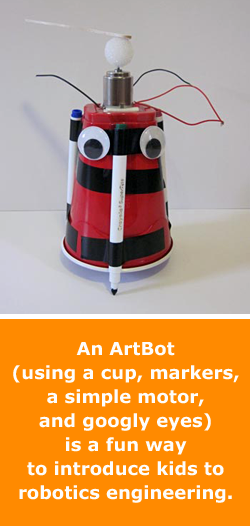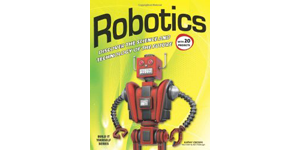Dive Into Robotics with Robotics: Discover the Science and Technology of the Future
This great guide and collection of family-friendly activities lets kids explore the history of robotics and put robotics engineering concepts to use with hands-on projects at home.
Introduce Students to Robotics Engineering
Robotics: DISCOVER THE SCIENCE AND TECHNOLOGY OF THE FUTURE with 20 PROJECTS is fast-paced and full of fascinating and inspiring robotics information, history, trivia, and try-it-out activities.
Luckily, getting started with hands-on robotics projects isn't difficult! Parents looking to do fun engineering activities with their students at home can easily wile away an afternoon helping kids create simple bots—ones that use electronics and ones that do not. The Science Buddies Robotics area offers several projects that are great for students to do independently or fun for families to do together.
For families with students hungry for more robotics ideas and information, Robotics: DISCOVER THE SCIENCE AND TECHNOLOGY OF THE FUTURE with 20 PROJECTS (Nomad Press), written by Kathy Ceceri and illustrated by Sam Carbaugh, is a great choice. Robotics offers up a really accessible nuts-and-bolts and everything-but-the-kitchen-sink-about-robotics resource aimed at students and families—no prior experience or expertise required. In addition to being chock full of information, history, trivia, tidbits, facts, and STEM concepts related to robotics, Robotics contains 20 do-it-yourself projects that put robotics concepts to use, encouraging students to learn by active exploration with DIY projects that use readily-available materials.
Robotics 101
Robotics does a great job presenting a ton of historical and scientific information in a really accessible, fun, and easy-to-read format. Pages are broken up with plenty of call-out boxes that define "Words to Know," offer "Fun Facts," highlight additional robot trivia (like what the LilyPad Arduino is and how fashion designer Shannon Henry used it to make the Skirt Full of Stars), or tell a side story related to the main text (the story of Dean Kamen's Segway, for example). Readers will find reference to all kinds of robot tidbits, like the Roomba (and how developers hacked it to do other things), Turtle Robots, Google's self-driving car, Honda's ASIMO, biomimetic robots, robots built with legs made from Tinkertoys, ones built from rubber bicycle tubing, and more. Though the book is black and white, there are plenty of fun illustrations scattered throughout Robotics.
Overall, the format is fun and invites readers to read straight through or to pick the book up and hone in on some of the discrete boxes of information. No matter what page you open to, you can find standalone boxes to read. Ceceri does a great job setting a rapid pace that offers readers lots of information, and lots of explanation, and yet keeps the tone accessible and engaging. This is not a book readers will need to slog through, but be prepared to jot down some notes because Ceceri moves quickly!
Robotics Then and Now
The history of robotics engineering probably dates back much farther than you think, especially if your first thoughts of "historical" robots stem from something like Star Wars or classic science fiction like Arthur C. Clarke's (novel) or Stanley Kubrick's (film) 2001 A Space Odyssey.
In Robotics, Ceceri does a nice job first setting up common definitions of what a robot is, based on what she defines as the "Sense-Think-Act" cycle, a cycle which dictates that a true robot senses (takes in information), thinks (processes info to determine what to do), and then acts (does something based on the info). Readers are then challenged to use the Sense-Think-Act model criteria to see how many things around them qualify as "robots." A handy "Robot... Or Not a Robot" flowchart makes a scavenger-hunt game of the activity and gets kids thinking about their remote controls, game controllers, garage door openers, and other household devices and electronics in new ways.
[Note: Not all scientists agree with the Sense-Think-Act cycle though, a fact that Ceceri notes. Many of the robots described in the book or included in the book's projects are, in fact, not ones that fit the formal and "brains"-dependent definition.]
After setting the stage for how to think about "robotics" and "robots," Robotics takes readers traipsing through a star-studded history of robotics engineering, including automata (familiar to Hugo readers/watchers), seemingly magical music-making theremin, and big names like Leonardo da Vinci, Ada Lovelace, and Tesla. The history tracks a progression of invention that leads to modern robotics and also underscores the diversity of robotics engineering. Robotics come in all shapes and sizes and appear in all fields, including the arts, medicine, military, space exploration, and business.
Robotics Engineering from Head to Toe
Robotics: DISCOVER THE SCIENCE AND TECHNOLOGY OF THE FUTURE with 20 PROJECTS includes steps for building a simple ArtBot. To expand the project, see Science Buddies' Art Bot: Build a Wobbly Robot Friend That Creates Art project. After building the robot, students explore how attaching different weights to the motor changes the way the ArtBot draws.
The Bristlebot kit in the Science Buddies Store contains the electronics parts needed to make an Artbot and to explore other simple robots using Science Buddies Project Ideas.
- A chapter on "housing" covers the exteriors or bodies of robots and raises questions about size, hardness, flexibility, and more.
- A chapter on "actuators" covers how engineers make robots move. This chapter gives readers a mini crash course in electronics, including motor basics, circuits, and current. Principles like force and torque are covered, as are concepts like servo motors, hydraulics, pneumatics, solar energy, and more.
- A chapter on "effectors" covers how robots "do" things using arms, tools, speakers, grippers, and other elements that engineering design to enable robots to perform tasks. The discussion includes degrees of freedom (the different directions in which a robotic part can move).
- A chapter on "sensors" covers how robots can tell what is happening or how they take in information. This chapter includes discussion of levers, photoresistors, emitters, ultraviolet sensors, sonar, radar, and lidar.
- A chapter on "controllers" covers how robots think. This chapter includes a summary of if-then programming logic, subroutines, and procedures. Ceceri provides an overview of Logo and three hands-on activities that let kids experiment with basic Logo commands. A cool Binary Bead Jewelry project lets kids use ASCII code to spell out words using beads and paperclips.
Exploring Robotics with DIY Projects
Embedded throughout Robotics are 20 robotics activities that can be done at home with easy-to-find materials. The activities are fun, fast, don't require many specialty items or electronics expertise, and let kids begin exploring how different parts can be used, combined, and housed in various exteriors and frameworks to accomplish different goals. The first building project in the book is the Art-Making Vibrobot. (A version of this robot appears at Science Buddies, too, in the Art Bot: Build a Wobbly Robot Friend That Creates Art science fair project idea!)
Other projects in Robotics include:
- Frubbery Robot Skin (a non-Newtonian fluid made from water and borax)
- BEAM-Type Solar Wobblebot (made from a solar panel mounted on top of a clear lid from a drinking cup, mounted on top of a CD, all balanced on a pencil eraser that moves around)
- Passive Dynamic Mini-Walker (no motor or power source)
- Robotic Hand (made from straws, cardboard, and string)
- Robotic Arm (made from cardboard, paper towel tubes, and needleless syringes to provide hydraulic power)
- Soft Robotic Gripper (made from a soda bottle, sugar, and a balloon)
- Rolling Ball Tilt Sensor (tilting triggers a greeting card sound device or other small motor or LED)
- Pressure Sensor (made from index cards, watch battery, an LED, and yarn)
Each project contains a simple materials list and numbered directions to guide the build. Illustration of the steps is limited, but these are simple enough projects that you should be able to follow along—and the building is the goal, not the testing of multiple variables (as you might in a science fair project). Even so, if you are a visual learner, you will probably wish there were a few more illustrations to show some of the assembly steps in action. But the range of projects is still fun and a nice mix of concepts and ideas to give young robotics engineers the satisfaction of building small robotics systems that "do" something and "work" when finished.
One for the Shelf
Overall, I was very impressed with the scope of Robotics: DISCOVER THE SCIENCE AND TECHNOLOGY OF THE FUTURE with 20 PROJECTS. There is so much packed into this book, and the format combined with Ceceri's excellent tone really work. That many of the concepts in Robotics match up to Science Buddies projects was also great to see. The "Uncanny Valley" is there, as is a brief discussion of theremin music devices. Discussions of hydraulics, soft robots, solar circuits, and more can also be paired with related projects at Science Buddies to extend the hands-on learning.
Categories:
You Might Also Enjoy These Related Posts:
- Book list for science-filled summer reading!
- New Series of Science Buddies Books
- Look Up: Bird and Astronomy Summer Reading
- Blending Science and Art with Paper Inventions
- Special Effects Fun with Nick and Tesla
- Nick and Tesla Build a Gadget Glove: Science Reading
- The Most Magnificent Thing: Science Reading
- Do Even More with Your Raspberry Pi Projects Kit












